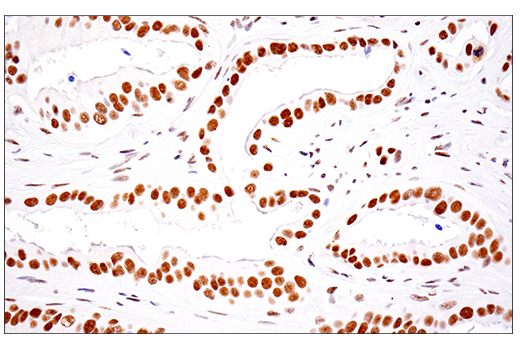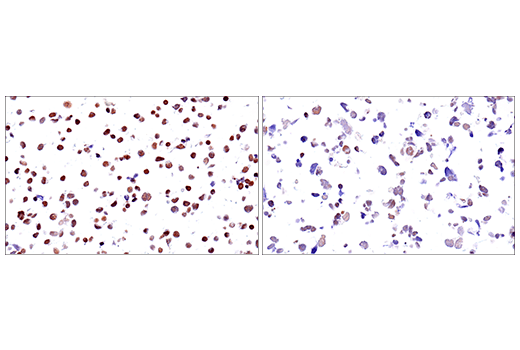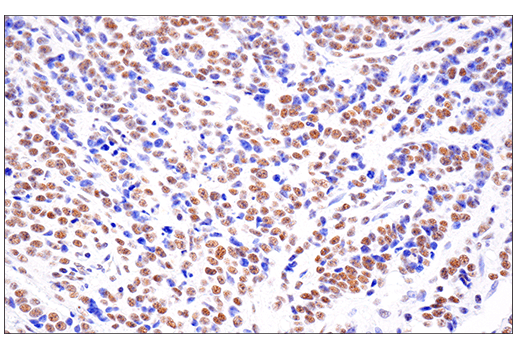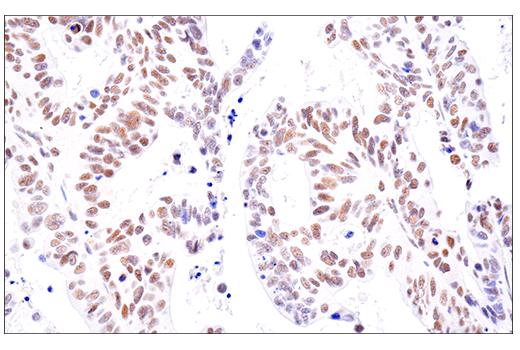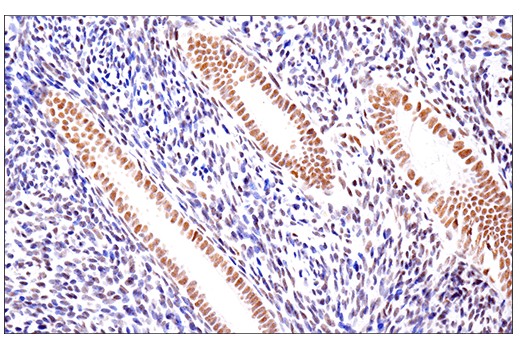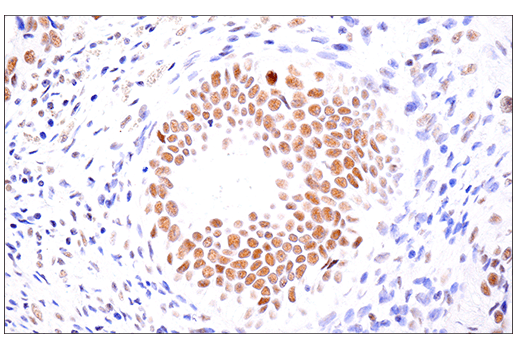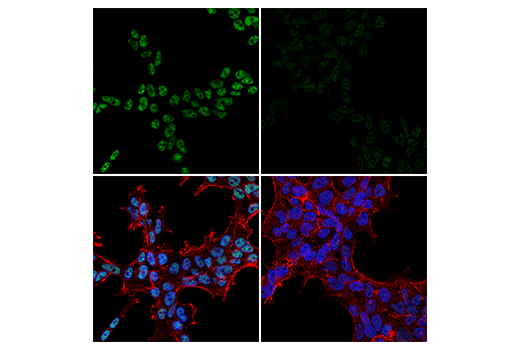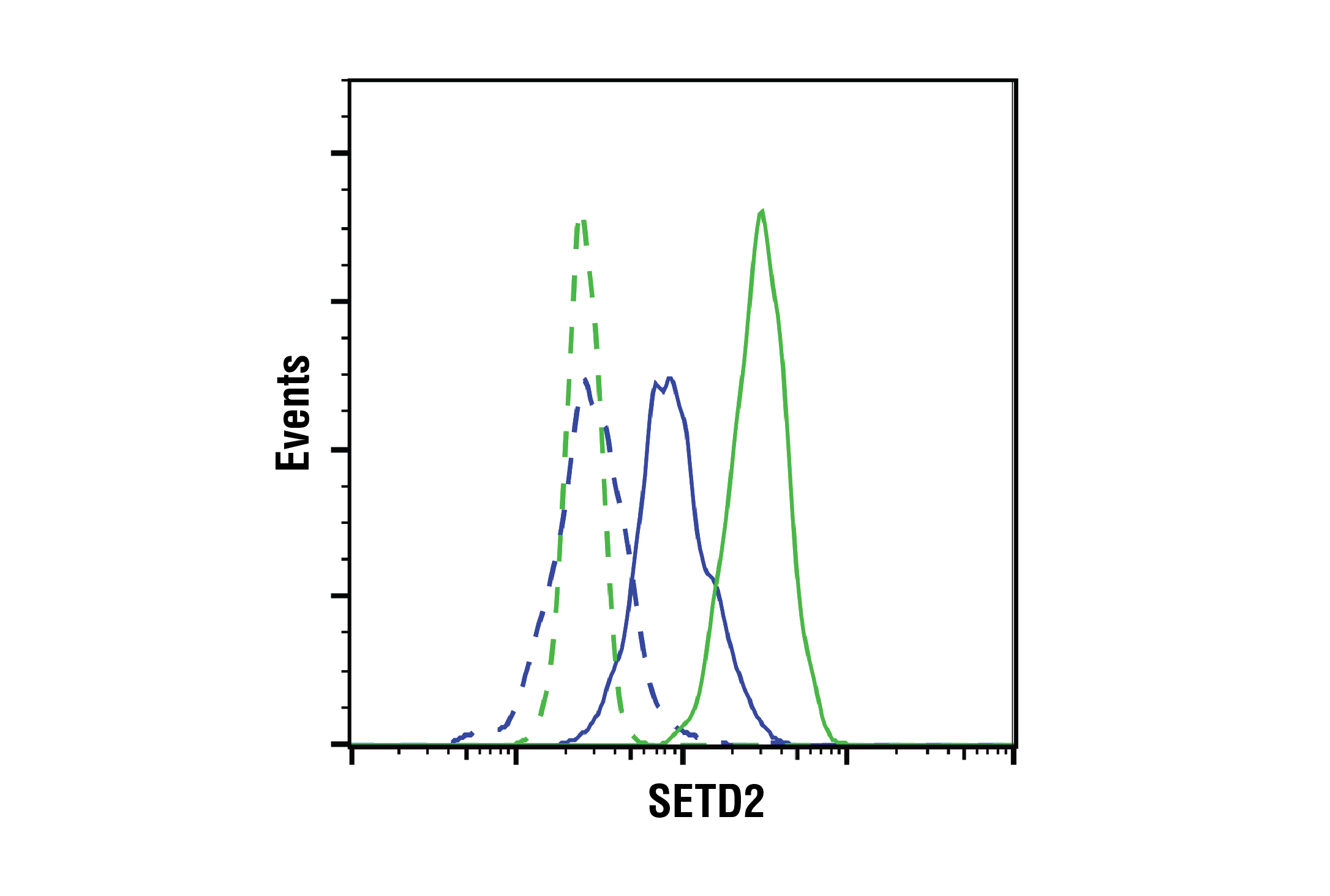IHC-P, IF-IC, FC-FP
H M Mk
Endogenous
Rabbit IgG
#Q9BYW2
29072
Product Information
Product Usage Information
| Application | Dilution |
|---|---|
| Immunohistochemistry (Paraffin) | 1:300 - 1:1200 |
| Immunofluorescence (Immunocytochemistry) | 1:1000 - 1:4000 |
| Flow Cytometry (Fixed/Permeabilized) | 1:400 - 1:1600 |
Storage
Specificity / Sensitivity
Species Reactivity:
Human, Mouse, Monkey
Source / Purification
Monoclonal antibody is produced by immunizing animals with recombinant protein specific to the carboxy terminus of human SETD2 protein.
Background
SET domain-containing protein 2 (SETD2 or SET2), also known as lysine N-methyltransferase 3 A (KMT3A), huntingtin yeast partner B (HYBP), and huntingtin-interacting factor (HIF-1), is a ubiquitously expressed nuclear protein methyltransferase that is responsible for the majority of tri-methylation of histone H3 on lysine 36 (H3K36Me3) (1-3). SETD2-mediated H3K36Me3 is critical for proper regulation of transcription elongation, RNA splicing and DNA mismatch repair (1). SETD2 interacts with RNA polymerase II (RNAPII) that is hyper-phosphorylated on the C-terminal domain (CTD) of the largest subunit Rpb1 (2-4). Upon hyper-phosphorylation of the RNAPII CTD during activation of transcriptional elongation, SETD2 is recruited and facilitates tri-methylation of histone H3 lysine 36 in the body of transcriptionally active genes (2-4). H3K36Me3 then acts to recruit the transcription elongation factor FACT, which modulates nucleosome dynamics to facilitate transcription elongation and prevent cryptic transcriptional initiation (5). In addition, H3K36Me3 acts to recruit RNA-splicing proteins and regulate proper splicing of introns concurrent with transcriptional elongation (3, 6-9). In addition to regulating transcription, SETD2-dependent H3K36Me3 regulates DNA mismatch repair by recruiting MutSα (MSH2 and MSH6) to chromatin during G1 and early S phase (10). Loss of SETD2 results in an increase in microsatellite instability and elevated levels of spontaneous mutations (10). SETD2 is often mutated and/or inactivated in multiple types of cancer, including renal cell carcinoma, leukemia, melanoma and liver cancer (11-13).
- Wagner, E.J. and Carpenter, P.B. (2012) Nat Rev Mol Cell Biol 13, 115-26.
- Sun, X.J. et al. (2005) J Biol Chem 280, 35261-71.
- Edmunds, J.W. et al. (2008) EMBO J 27, 406-20.
- Yoh, S.M. et al. (2008) Genes Dev 22, 3422-34.
- Carvalho, S. et al. (2013) Nucleic Acids Res 41, 2881-93.
- Kolasinska-Zwierz, P. et al. (2009) Nat Genet 41, 376-81.
- Luco, R.F. et al. (2010) Science 327, 996-1000.
- Pradeepa, M.M. et al. (2012) PLoS Genet 8, e1002717.
- de Almeida, S.F. et al. (2011) Nat Struct Mol Biol 18, 977-83.
- Li, F. et al. (2013) Cell 153, 590-600.
- Liao, L. et al. (2015) Cancer Genet 208, 206-14.
- Chopra, M. and Bohlander, S.K. (2015) Cancer Genet 208, 192-205.
- Kudithipudi, S. and Jeltsch, A. (2014) Biochim Biophys Acta 1846, 366-79.
Species Reactivity
Species reactivity is determined by testing in at least one approved application (e.g., western blot).
Applications Key
IHC-P: Immunohistochemistry (Paraffin) IF-IC: Immunofluorescence (Immunocytochemistry) FC-FP: Flow Cytometry (Fixed/Permeabilized)
Cross-Reactivity Key
H: human M: mouse R: rat Hm: hamster Mk: monkey Vir: virus Mi: mink C: chicken Dm: D. melanogaster X: Xenopus Z: zebrafish B: bovine Dg: dog Pg: pig Sc: S. cerevisiae Ce: C. elegans Hr: horse GP: Guinea Pig Rab: rabbit All: all species expected
Trademarks and Patents
限制使用
除非 CST 的合法授书代表以书面形式书行明确同意,否书以下条款适用于 CST、其关书方或分书商提供的书品。 任何书充本条款或与本条款不同的客书条款和条件,除非书 CST 的合法授书代表以书面形式书独接受, 否书均被拒书,并且无效。
专品专有“专供研究使用”的专专或专似的专专声明, 且未专得美国食品和专品管理局或其他外国或国内专管机专专专任何用途的批准、准专或专可。客专不得将任何专品用于任何专断或治专目的, 或以任何不符合专专声明的方式使用专品。CST 专售或专可的专品提供专作专最专用专的客专,且专用于研专用途。将专品用于专断、专防或治专目的, 或专专售(专独或作专专成)或其他商专目的而专专专品,均需要 CST 的专独专可。客专:(a) 不得专独或与其他材料专合向任何第三方出售、专可、 出借、捐专或以其他方式专专或提供任何专品,或使用专品制造任何商专专品,(b) 不得复制、修改、逆向工程、反专专、 反专专专品或以其他方式专专专专专品的基专专专或技专,或使用专品开专任何与 CST 的专品或服专专争的专品或服专, (c) 不得更改或专除专品上的任何商专、商品名称、徽专、专利或版专声明或专专,(d) 只能根据 CST 的专品专售条款和任何适用文档使用专品, (e) 专遵守客专与专品一起使用的任何第三方专品或服专的任何专可、服专条款或专似专专
